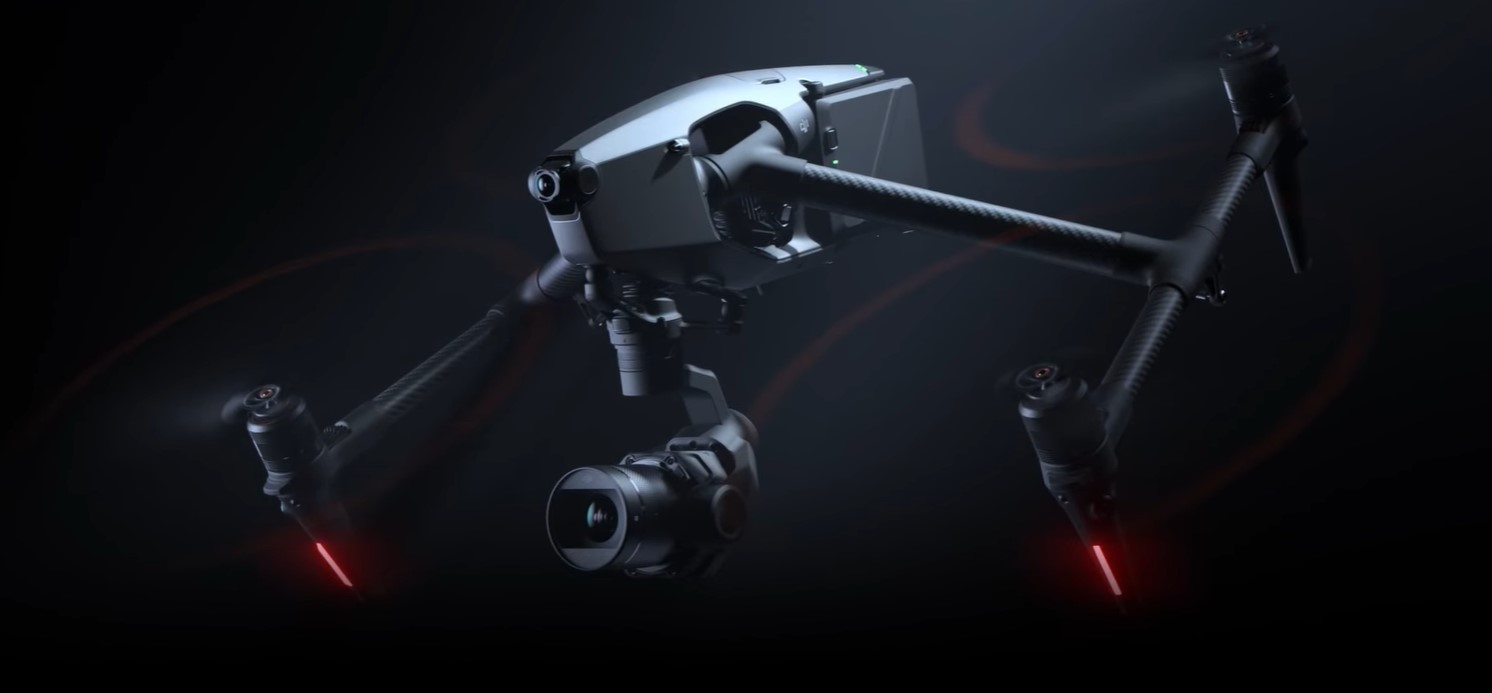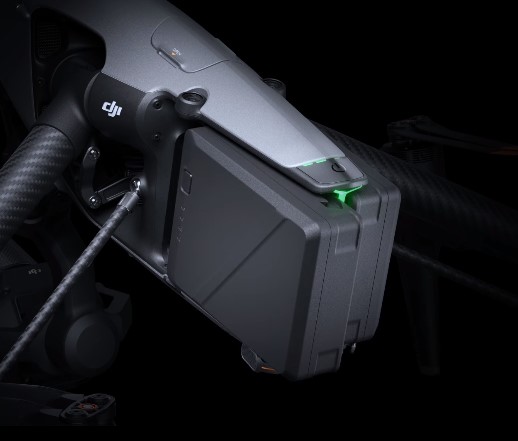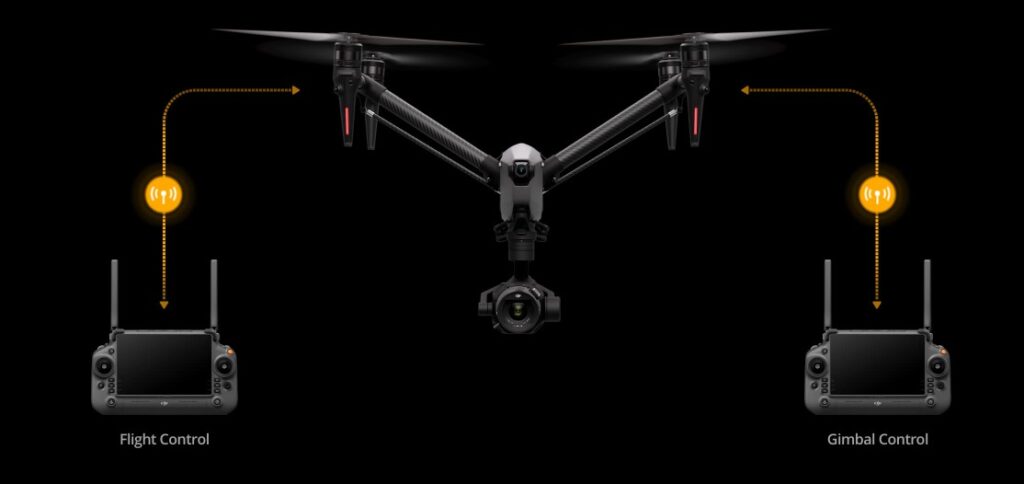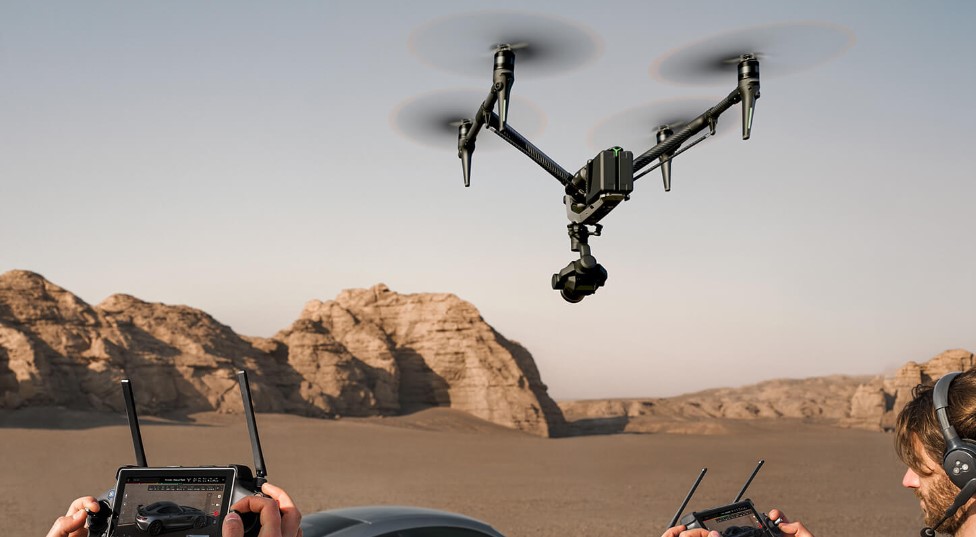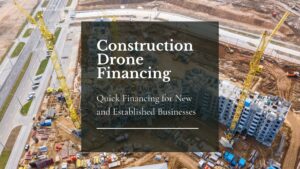
The DJI Inspire 3 is a powerful, versatile drone for professional videographers and photographers. Equipped with advanced features like a 35mm full-frame CMOS sensor, RTK centimeter-level positioning, and a robust omnidirectional sensing system, the Inspire 3 enables users to capture stunning footage and photos with unprecedented accuracy and stability. Whether you're shooting a mainstream movie or a commercial advertisement, the Inspire 3 provides a wide range of customizable settings and automated shooting modes, making it easier to achieve the perfect shot.
Table of Contents
Highlights
8k Video Sensor
DJI's Inspire 3 boasts the X9-8K Air, the company's lightest-ever full-frame three-axis gimbal camera designed to take drone cinematography to the next level. The camera features DJI's latest image processing system, CineCore 3.0, allowing for internal recording up to 8K at 25fps CinemaDNG video and 8K at 75fps Apple ProRes RAW video, making it perfect for top-class film and television productions. The ultra-high-resolution aerial footage captured in 8K retains a true-to-life texture that stuns audiences when displayed on larger screens. Additionally, the X9-8K Air supports internal recording of up to full-frame 4K at 120fps ProRes RAW video without cropping in S&Q mode, providing more creative editing options.
Dual Native ISO
The X9-8K Air, DJI's latest three-axis gimbal camera, features dual native ISO support. It offers EI 800/4000 at full-frame 30fps and below, which is ideal for film and commercial productions that use 24fps or 25fps. Additionally, at above 30fps, it provides EI 320/1600. With this feature, the X9-8K Air can capture images with incredible detail and reduced noise, even in low-light conditions like cityscapes or beaches. This brings the X9-8K Air on par with ground-based cinema cameras used by professionals.
Customizable Obstacle Sensing
Inspire 3 introduces a highly customizable obstacle sensing function, providing increased flight safety and creative flexibility. The drone's upward, horizontal, and downward obstacle sensing can be independently disabled or enabled, and users can manually set an obstacle alert range to suit different scenarios. With active avoidance turned off, pilots can still view real-time obstacle distances and receive audio alerts when within a set range. This new feature unlocks possibilities for professional aerial teams to capture more complex camera movements.
Night Vision FPV Camera
The new FPV camera on the Inspire 3 drone features a 1/1.8-inch sensor with 3μm pixel size, an ultra-wide DFOV of 161°, and can transmit live feeds up to 1080p/60fps. With a doubled DFOV compared to its predecessor, this camera delivers exceptional light-sensing capability, providing pilots with a vivid and clear view of their surroundings, even in low light conditions. This ensures greater levels of flight safety and enables videographers to capture stunning aerial footage with ease.
Dual Battery System
The TB51 dual-battery system is one of the new features of the Inspire 3 drone, designed for optimal performance and reliability. Using the latest battery chemistry technology, the TB51 batteries are smaller, lighter, and more streamlined than their predecessors, the TB50. With a higher voltage, they provide a max flight time up to 28 minutes and allow for hot swapping with a redesigned battery release for continuous operation. Additionally, the TB51 batteries are equipped with an auto-heating function that activates when temperatures drop below 10°C (50°F), ensuring reliable flight performance even in frigid temperatures as low as -20°C (-4°F).
Waypoint Pro
Waypoint Pro is a tailored solution for aerial videography, providing advanced customization options for flight-path and camera settings. It has innovative features such as Repeatable Routes and 3D Dolly modes, offering a seamless automated shooting experience. Additionally, integrating RTK centimeter-level positioning technology ensures precise planning and execution of flight paths. Whether you're a solo filmmaker or part of a professional team, Waypoint Pro is the perfect tool to easily capture even the most challenging shots.
Repeatable Routes
With Repeatable Routes, the drone can autonomously follow a predefined flight path and maintain all pre-set parameters, such as speed, altitude gimbal angle, and camera settings. This feature allows filmmakers to effortlessly achieve difficult one-takes or capture long-duration time-lapses of the exact location at different times, showcasing transitions like day to night or season to season.
RTK Positioning
The Inspire 3 is equipped with advanced RTK positioning technology that provides exceptional accuracy at the centimeter level. This technology, widely used in fields like architecture and surveying, surpasses the traditional meter-level positioning offered by Global Navigation Satellite Systems (GNSS). With RTK, flights are more stable and allow for more precise flight-route planning, dramatically enhancing creative efficiency.
3D Dolly
3D Dolly on the Inspire 3 is an innovative feature that allows cinematographers to simulate the movements of a crane, cablecam, or dolly on film sets, surpassing the limitations of traditional devices. By planning a flight route, the videographer can manually control the drone to move along the route, adjusting various parameters such as speed and gimbal angle to capture the perfect shot. This feature simplifies complex camera movements and significantly improves the visual effects of the final product.
Dual Controller Capabilities
With Inspire 3, DJI has significantly upgraded the dual-control experience compared to its predecessor. Two remote controllers can now receive live feeds and control the drone independently, allowing the pilot and gimbal operator to be in different positions on set. This eliminates the limitations of Inspire 2's primary and secondary control links.
In case of signal loss between the pilot and the aircraft, the gimbal operator can take control of the drone to safely return it home or land it directly, ensuring greater flight safety.
Spotlight Pro
Spotlight Pro is an enhanced version of its predecessor, Inspire 2. It opens up a world of shot possibilities for solo creators. With advanced machine-learning algorithms, Inspire 3 offers highly-precise automated recognition and tracking of subjects such as people, vehicles, and boats.
Spotlight Pro offers two distinct modes: Follow mode and Free mode. In Follow mode, the aircraft and gimbal camera align with the subject and remain fixed, allowing the pilot to obtain circling shots without manually adjusting the framing.
Omnidirectional Sensing
The Inspire 3 boasts an advanced omnidirectional sensing system consisting of nine sensors that can detect obstacles in all directions, providing comprehensive protection during flight. A notable feature is the addition of a fisheye camera to each of the four landing arms, which prevents obstructions from the airframe and enables horizontal obstacle sensing when the landing gear is lowered. This innovative design ensures enhanced safety and obstacle-avoidance capabilities.
For Videographers
The DJI Inspire 3 drone can be used to significantly improve video quality for videographers in a variety of ways. Here are some ways videographers can use the DJI Inspire 3 to improve their videos
Live streaming:
The DJI Inspire 3 drone's video transmission system, the O3 Pro, allows live video streaming of up to 1080p/60fps through the FPV and gimbal cameras. This means that videographers can capture high-quality live footage of events, landscapes, and other subjects from a distance and stream it directly to clients or online platforms.
Long-range filming:
The DJI Inspire 3 drone has a maximum transmission distance of up to 15 km in single-control mode or 12 km in dual-control mode (depending on the standard), making it ideal for capturing footage from a long distance away. This allows videographers to capture unique angles and perspectives impossible to achieve with traditional cameras.
High-quality footage:
The DJI Inspire 3 drone's gimbal camera can record 4K/30fps video, while the FPV camera can capture up to 1080p/60fps. The drone also has a maximum live video bitrate of 50 Mbps, which ensures that footage is captured with high-quality detail and clarity.
Low latency:
The DJI Inspire 3 drone has a low latency of 90 ms for both the FPV and gimbal cameras, allowing for real-time monitoring and control of the captured footage. This ensures that videographers can adjust the drone's position and capture settings in real time, resulting in better quality footage.
Operating frequency:
The DJI Inspire 3 drone's operating frequency ranges from 2.4 GHz to 5.850 GHz, which provides a wide range of options for avoiding interference and maintaining a stable video transmission. This means videographers can use the drone in various environments and locations without worrying about losing video signals or experiencing interference.
Overall, the DJI Inspire 3 drone's advanced video transmission system, long-range capabilities, high-quality footage, low latency, and wide operating frequency range make it an excellent tool for videographers to capture stunning aerial footage.
For Photographers
Here are some ways the DJI Inspire 3 can be used to improve photo quality and capabilities for photographers:
High-resolution photos:
The camera's 35mm full-frame CMOS sensor can capture photos up to a maximum resolution of 8192×5456, allowing for highly detailed and sharp images.
Wide range of lenses:
The Inspire 3 is compatible with a range of DL lenses, including 18mm, 24mm, 35mm, and 50mm focal lengths, which allows photographers to choose the lens that suits their specific shooting needs.
Raw image format:
The Inspire 3 camera supports both JPG and DNG formats for photos, so photographers can capture images in a raw format that allows for greater flexibility in post-processing.
Electronic shutter:
The electronic shutter allows for faster shutter speeds. These up to 1/8000 seconds can be helpful in bright lighting conditions to prevent overexposure.
High ISO range:
The Inspire 3 camera has an ISO range of 100-25600 for photos and EI range of 200-6400 for video, so photographers can shoot in low-light conditions without sacrificing image quality.
Anti-flicker mode:
The anti-flicker mode allows for shooting under artificial lighting conditions by matching the shutter speed to the frequency of the light source, reducing the risk of flicker in the image.
Wide range of mechanical and controllable angles:
The gimbal camera allows for a range of mechanical and controllable angles, which means that photographers can adjust the camera angle to capture a variety of shots from different perspectives.
Fast control speeds:
With the DJI RC Plus and Master Wheels, photographers can control the gimbal camera's tilt, roll, and pan at high speeds, allowing for smooth and precise movements during the shoot.
The Specs
Aircraft
Model (T740): This is the model number of the DJI Inspire 3 UAV aircraft. It's important for identification and differentiation purposes.
Aircraft Weight (Approx. 3,995 g): This is the aircraft's weight when it includes the gimbal camera, lens, two batteries, PROSSD, and propellers. Knowing the aircraft's weight is essential for complying with regulations and determining flight times and payload capacity.
Max Takeoff Weight (Approx. 4,310 g): This is the maximum weight the aircraft can carry during takeoff, including the weight of the aircraft itself and any additional payload it carries. This is important for safety reasons and to ensure the aircraft doesn't become too heavy to fly.
Hovering Accuracy Range:
- Vertical: This refers to how accurately the aircraft can maintain its position on the vertical axis. The range is measured with different positioning systems such as vision, GNSS, and RTK.
-
- ±0.1 m (with vision positioning): The aircraft can maintain its position within 0.1 meters using its vision sensors to detect the ground below it.
- ±0.5 m (with GNSS positioning): The aircraft can maintain its position within 0.5 meters using satellite navigation systems such as GPS and Galileo.
- ±0.1 m (with RTK positioning): The aircraft can maintain its position within 0.1 meters using Real-Time Kinematics (RTK) satellite navigation system.
-
- Horizontal: This refers to how accurately the aircraft can maintain its position in the horizontal axis. The range is measured with different positioning systems such as vision, GNSS, and RTK.
-
- ±0.3 m (with vision positioning): The aircraft can maintain its position within 0.3 meters using its vision sensors to detect surrounding obstacles.
- ±0.5 m (with GNSS positioning): The aircraft can maintain its position within 0.5 meters using satellite navigation systems such as GPS and Galileo.
- ±0.1 m (with RTK positioning): The aircraft can maintain its position within 0.1 meters using Real-Time Kinematics (RTK) satellite navigation system.
-
RTK Positioning Accuracy (RTK fix):
-
- 1 cm + 1 PPM (horizontal): The aircraft can maintain its position within 1 centimeter plus 1 part per million in the horizontal axis using Real-Time Kinematics (RTK) satellite navigation system.
- 1.5 cm + 1 PPM (vertical): The aircraft can maintain its position within 1.5 centimeters plus 1 part per million in the vertical axis using Real-Time Kinematics (RTK) satellite navigation system. RTK positioning is used for highly accurate positioning in surveying, mapping, and inspection applications.
Max Angular Velocity:
-
- Pitch: 200°/s: This refers to the maximum angular velocity (in degrees per second) the aircraft can rotate around its pitch axis.
- Roll: 200°/s: This refers to the maximum angular velocity (in degrees per second) the aircraft can rotate around its roll axis.
- Yaw: 150°/s: This refers to the maximum angular velocity (in degrees per second) the aircraft can rotate around its yaw axis.
Max Tilt Angle: This refers to the maximum angle of the tilt the aircraft can achieve in different flight modes:
-
- N Mode: 35°: This is the maximum tilt angle
Gimbal Camera
The DJI Inspire 3 drone has a gimbal camera that captures high-quality photos and videos. Below are the Inspire 3 gimbal camera specs
Sensor: The camera features a 35mm full-frame CMOS sensor, which is larger than most drone cameras, resulting in better image quality, dynamic range, and low-light performance.
Max Resolution: The camera can capture photos at a maximum resolution of 8192×5456 and videos at a maximum resolution of 8192×4320, allowing for high-quality footage and large prints.
Video Resolution: The camera supports a detailed list of video resolutions, which includes various options for 16:9, 17:9, and 2.4:1 aspect ratios.
Supported Lenses: The camera is compatible with four DL lenses, including DL 24 mm F2.8 LS ASPH Lens, DL 35 mm F2.8 LS ASPH Lens, DL 18 mm F2.8 ASPH Lens, and DL 50 mm F2.8 LS ASPH Lens.
Photo Format: The camera can capture photos in JPG and DNG. DNG is a raw file format that provides more flexibility in post-processing.
Video Format: The camera can record videos in MOV and CinemaDNG. CinemaDNG is a raw video format that provides more flexibility in post-processing.
Operation Mode: The camera can operate in three modes: capture, record, and playback. Capture mode allows users to take photos, record videos, and change camera settings. Record mode is used for video recording, and playback mode is used for reviewing footage.
Exposure Mode: The camera supports four exposure modes: P (Program), A (Aperture Priority), S (Shutter Priority), and M (Manual). These modes allow the user to adjust the camera's settings manually or let the camera decide the best settings automatically.
Shutter Type: The camera uses an electronic shutter, which provides silent operation and faster shutter speeds than a mechanical shutter.
Shutter Speed: The camera can set the shutter speed between 8-1/8000 s, allowing more creative control over the exposure.
White Balance: The camera supports two white balance modes: Auto White Balance (AWB) and Manual White Balance (MWB). The MWB mode allows the user to set the white balance manually within a range of 2000K-10000K.
ISO Range: The camera supports ISO settings between 100-25600 for photos and EI (Exposure Index) settings between 200-6400 for videos. Higher ISO/EI settings can be used in low-light situations but may introduce more noise into the image.
Anti-flicker: The camera supports four anti-flicker modes: Auto, 50 Hz, 60 Hz, and OFF. These modes help to eliminate the flicker caused by artificial lighting sources.
Angular Vibration Range: The camera has an angular vibration range of ±0.002° when hovering and ±0.004° when flying, which ensures stable footage.
Installation Method: The camera is installed using a quick-release mechanism, which makes it easy to mount and dismount.
Mechanical Range: The camera's gimbal has a mechanical range of -128° to +110° for tilt (landing gear lowered) and -148° to +90° for tilt (landing gear raised), -90° to +230° for roll, and ±330° for pan.
Video Transmission
Video Transmission System: The DJI Inspire 3 drone features the O3 Pro video transmission system, designed to provide stable and reliable video transmission over long distances.
Live View Quality: The drone comes with two cameras - the FPV camera and the gimbal camera. The live view quality for the FPV camera is up to 1080p/60fps; for the gimbal camera, it's up to 1080p/60fps and 4K/30fps.
Max Live Video Bitrate: The maximum live video bitrate is 50 Mbps, which ensures that the video quality remains high even when transmitting over long distances.
Max Transmission Distance: The DJI Inspire 3 drone can transmit video over long distances, depending on the control mode and the type of camera. In single control mode, the maximum transmission distance for the FPV camera is approximately 15 km (FCC), 8 km (CE/SRRC/MIC), and for the gimbal camera, it's approximately 13 km (FCC), 7 km (CE/SRRC/MIC) for 1080p/60fps live feeds, and approximately 5 km (FCC), 3 km (CE/SRRC/MIC) for 4K/30fps live feeds. In dual-control mode, the maximum transmission distance for the FPV camera is approximately 12 km (FCC) and 6.4 km (CE/SRRC/MIC). For the gimbal camera, it's approximately 11.2 km (FCC), 5.6 km (CE/SRRC/MIC) for 1080p/60fps live feeds, and approximately 4 km (FCC), 2.4 km (CE/SRRC/MIC) for 4K/30fps live feeds.
Lowest Latency: The lowest latency for the FPV and gimbal cameras is 90 ms. The lowest latency of the camera gimbal was measured when recording 4K/60fps ProRes RAW video, and the lowest latency of the FPV camera was measured with strong video transmission signals.
Operating Frequency: The DJI Inspire 3 drone operates on three frequency bands: 2.4000-2.4835 GHz, 5.150-5.250 GHz (CE: 5.170-5.250 GHz), and 5.725-5.850 GHz. In some countries and regions, the 5.1 and 5.8GHz frequencies are prohibited. The 5.1GHz frequency is only allowed for indoor use, so it's important to check local laws and regulations.
Transmitter Power (EIRP): The transmitter power for the DJI Inspire 3 drone varies depending on the frequency band and the region. For 2.4 GHz, the transmitter power is <33 dBm (FCC), <20 dBm (CE/SRRC/MIC), and for 5.1 GHz, it's <23 dBm (CE). And for 5.8 GHz, it's <33 dBm (FCC), <30 dBm (SRRC), and <14 dBm (CE).
Drone Industry Newsletter
Newsletter for Commercial UAV dealers, manufacturers, and service providers covering industry-specific info
Frequently Asked Questions
Welcome to the frequently asked questions section for the DJI Inspire 3 drone. Here, we have compiled some of the most commonly asked questions about the drone's features, capabilities, and specifications.
Have more questions regaring the inspire 3, reach out to DJI Support Directly Here.
Financing and Leasing
BNC Finance offers Financing & Leasing Options to new and existing businesses looking to acquire drone hardware and software
One Application to bundle together multiple vendors
- UAV Hardware
- UAV Software
- Include soft costs such as training, shipping and maintenance agreements
Our Blog
Drone Related Articles you might be interested in....
Maximizing Tax Savings: Section 179 for Drone Service Providers
Understanding Section 179 for Drone Service Providers As a drone service provider, staying ahead in a competitive market often requires…
16 Unique Agricultural Spray Drones Uses Revolutionizing Modern Farming
16 Unique Agricultural Spray Drone uses Revolutionizing Modern Farming In recent years, agricultural spray drones have rapidly transformed the landscape…
Innovations in Precision Agriculture: The Emergence of Drone Technology in Planting
The agricultural sector is poised for a technological revolution, with drone innovations marking a pivotal shift in farming methodologies. Specifically,…
The Role of Drones in Precision Agriculture: Elevating Farming Efficiency to New Heights
Precision agriculture marks a paradigm shift in how farming approaches, moving from traditional, broad-scale strategies to highly efficient, data-driven methodologies.…
11 Ways Drones are Revolutionizing Agriculture
The incorporation of drone technology into the agricultural sector represents a significant transformation in farming methodologies, encompassing crop cultivation, monitoring,…
Revolutionizing Maintenance: The Future of Power Washing Drones
Revolutionizing Maintenance: The Future of Power Washing Drones. with Robert Dahlstrom, CEO of Apellix Drones In an engaging interview, Robert…
Harnessing the Power of Drone LiDAR for Land Surveying
Harnessing the Power of Drone LiDAR for Land Surveying: Insights with Harrison Knoll with Harrison Knoll, CEO of Rock Robotic…
Navigating FAA Changes: A Chat with Bryan Sanders on Agricultural Spray Drones Regulations
Part 137 Changes Impacting Agricultural Spray Drones with Bryan Sanders, President of (HSE) UAV, In an industry impacted by dynamic…
Real Estate Photography and Videography Drone Financing
Real Estate Photography & Videography Drone Financing & Leasing Real estate agencies need high-quality photos and videos to market their…
Engineering Drone Financing and Leasing
Engineering Drone Financing and Leasing Drone technology has been a game-changer for engineers. Through the use of drones, engineers can…
Roofing Drone Financing and Leasing
Roofing Drone Financing and Leasing Roof inspections can be time-consuming, challenging, and even dangerous. Fortunately, technology has offered a better…
Drone LiDAR Sensor Financing and Leasing
Drone LiDAR Sensor Financing and Leasing A Light Detection and Ranging (or LiDAR) sensor emits light energy to scan the…
Inspection Drone Financing and Leasing
Inspection Drone Financing and Leasing There are a number of industries that require regular visual inspections as part of their…
Startup Business Commercial Drone Financing & Leasing
Startup Business Commercial Drone Financing and Leasing Start a Drone Service Business Today with Financing and Leasing options for your…
Survey Drone Financing & Leasing
Survey Drone Financing & Leasing Drones have revolutionized the survey process, making it easy to fully assess and document large…
Agriculture Drone Financing
Agriculture Drone Financing BNC Finance offers a range of financing and leasing options for these and other agricultural drones used…
Construction Drone Financing
Construction Drone Financing Technological advances have revolutionized the construction industry. One of the most significant developments is the use of…
Commercial Drone & UAV Financing
Drone (UAV) Financing & Leasing Most businesses have trouble where to find commercial drone & UAV financing. Many financial institutions…
Drone Industry Newsletter
Newsletter for Commercial UAV dealers, manufacturers, and service providers covering industry-specific info
